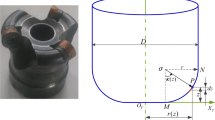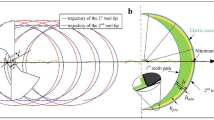Abstract
The previous research on machined surface topography in milling processes usually focuses on simple and single machining features such as free flat and form surfaces. However, the industrial components are composed of complex machining features such as slots and grooves finished by profile milling cutters. The formation mechanism and prediction method of machined surface topography for the complex milling features are required in industrial applications. Firstly, the machined side surface topography formation mechanism in profile milling straight slot machined by single-pass processing with a solid end mill is presented. Then, the numerical prediction models for machined side surface roughness in straight slot profile end milling are proposed. The proposed model can accurately predict the surface topography, and the relative prediction errors of the surface roughness (Sa) are within 6.34% for the whole cases in this research. Finally, the effect of cutting parameters on the residual heights of the machined side surface is analyzed. The formation mechanisms of machined two side surface topographies on the straight slot are distinct, for which one side surface is machined by up milling while another is by down milling. It is shown that the different tool trajectories cause the distinction for milling each slot side. The machined side surface topography can be controlled by selecting optimized tool motion parameters and cutting parameters. The influences of tool deflection and tool wear on the surface topography are ignored in the current research, which will be considered in the future.





















Similar content being viewed by others
Data availability
The raw data required to reproduce these findings cannot be shared at this time as the data also forms part of an ongoing study.
References
He CL, Zong WJ, Zhang JJ (2018) Influencing factors and theoretical modeling methods of surface roughness in turning process: state-of-the-art. Int J Mach Tools Manuf 129:15–26. https://doi.org/10.1016/j.ijmachtools.2018.02.001
Benardos PG, Vosniakos GC (2003) Predicting surface roughness in machining: a review. Int J Mach Tools Manuf 43:833–844. https://doi.org/10.1016/S0890-6955(03)00059-2
Peng Z, Jiao L, Yan P, Yuan M, Gao S, Yi J, Wang X (2018) Simulation and experimental study on 3D surface topography in micro-ball-end milling. Int J Adv Manuf Technol 96:1943–1958. https://doi.org/10.1007/s00170-018-1597-6
Arizmendi M, Fernández J, Gil A, Veiga F (2009) Effect of tool setting error on the topography of surfaces machined by peripheral milling. Int J Mach Tools Manuf 49:36–52. https://doi.org/10.1016/j.ijmachtools.2008.08.004
Surmann T, Biermann D (2008) The effect of tool vibrations on the flank surface created by peripheral milling. CIRP Ann 57:375–378. https://doi.org/10.1016/j.cirp.2008.03.059
Elbestawi MA, Ismail F, Yuen KM (1994) Surface topography characterization in finish milling. Int J Adv Manuf Technol 34:245–255. https://doi.org/10.1016/0890-6955(94)90104-X
Arizmendi M, Campa FJ, Fernández J, López De Lacalle LN, Gil A, Bilbao E, Veiga F et al (2009) Model for surface topography prediction in peripheral milling considering tool vibration. CIRP Ann 58:93–96. https://doi.org/10.1016/j.cirp.2009.03.084
Arizmendi M, Fernández J, Gil A, Veiga F (2010) Model for the prediction of heterogeneity bands in the topography of surfaces machined by peripheral milling considering tool runout. Int J Mach Tools Manuf 50:51–64. https://doi.org/10.1016/j.ijmachtools.2009.09.007
Yang D, Liu Z (2015) Surface plastic deformation and surface topography prediction in peripheral milling with variable pitch end mill. Int J Mach Tools Manuf 91:43–53. https://doi.org/10.1016/j.ijmachtools.2014.11.009
Chen H, Wang Q (2019) Modelling and simulation of surface topography machined by peripheral milling considering tool radial runout and axial drift. Proc Inst Mech Eng B J Eng Manuf 233:2227–2240. https://doi.org/10.1177/0954405419838384
Ismail F, Elbestawi MA, Du R, Urbasik K (1993) Generation of milled surfaces including tool dynamics and wear. J Eng Ind 115:245–252. https://doi.org/10.1115/1.2901656
Omar OEEK, El-Wardany T, Ng E, Elbestawi MA (2007) An improved cutting force and surface topography prediction model in end milling. Int J Mach Tools Manuf 47:1263–1275. https://doi.org/10.1016/j.ijmachtools.2006.08.021
Arizmendi M, Fernández J, Lacalle LNLD, Lamikiz A, Gil A, Sánchez JA, Campa FJ et al (2008) Model development for the prediction of surface topography generated by ball-end mills taking into account the tool parallel axis offset. Experimental validation CIRP Ann 57:101–104. https://doi.org/10.1016/j.cirp.2008.03.045
Zhang X, Yu T, Zhao J (2020) Surface generation modeling of micro milling process with stochastic tool wear. Precis Eng 61:170–181. https://doi.org/10.1016/j.precisioneng.2019.10.015
Chen W, Xie W, Huo D, Yang K (2018) A novel 3D surface generation model for micro milling based on homogeneous matrix transformation and dynamic regenerative effect. Int J Mech Sci 144:146–157. https://doi.org/10.1016/j.ijmecsci.2018.05.050
Insperger T, Gradišek J, Kalveram M, Stépán G, Winert K, Govekar E (2006) Machine tool chatter and surface location error in milling processes. J Manuf Sci Eng 128:913–920. https://doi.org/10.1115/1.2280634
Liu C, Gao L, Wang G, Xu W, Jiang X, Yang T (2020) Online reconstruction of surface topography along the entire cutting path in peripheral milling. Int J Mech Sci 185:105885. https://doi.org/10.1016/j.ijmecsci.2020.105885
Li S, Dong Y, Li Y, Li P, Yang Z, Landers RG (2019) Geometrical simulation and analysis of ball-end milling surface topography. Int J Adv Manuf Technol 102:1885–1900. https://doi.org/10.1007/s00170-018-03217-5
Luo M, Mei J, Zhang D (2016) Time-domain modeling of a cutter exiting a workpiece in the slot milling process. Chin J Aeronaut 29:1852–1858. https://doi.org/10.1016/j.cja.2016.10.014
Bagherzadeh A, Kuram E, Budak E (2021) Experimental evaluation of eco-friendly hybrid cooling methods in slot milling of titanium alloy. J Clean Prod 289:125817. https://doi.org/10.1016/j.jclepro.2021.125817
Wang M, Chang H (2004) Experimental study of surface roughness in slot end milling AL2014-T6. Int J Mach Tools Manuf 44:51–57. https://doi.org/10.1016/j.ijmachtools.2003.08.011
Markopoulos AP, Karkalos NE, Mia M, Pimenov DY, Gupta MK, Hegab H, Khanna N, Aizebeoje Balogun V, Sharma S (2020) Sustainability assessment, investigations, and modelling of slot milling characteristics in eco-benign machining of hardened steel. Metals 10:1650. https://doi.org/10.3390/met10121650
Osman KA, Yılmaz V, Ünver HÖ, Şeker U, Kılıç SE (2020) Slot milling of titanium alloy with hexagonal boron nitride and minimum quantity lubrication and multi-objective process optimization for energy efficiency. J Clean Prod 258:120739. https://doi.org/10.1016/j.jclepro.2020.120739
Liu N, Wang SB, Zhang YF, Lu WF (2016) A novel approach to predicting surface roughness based on specific cutting energy consumption when slot milling Al-7075. Int J Mech Sci 118:13–20. https://doi.org/10.1016/j.ijmecsci.2016.09.002
Sabberwal AJP (1961) Chip section and cutting force during the milling operation. CIRP Ann Manuf Technol 10:197–203
Lee P, Altintaş Y (1996) Prediction of ball-end milling forces from orthogonal cutting data. Int J Mach Tools Manuf 36:1059–1072. https://doi.org/10.1016/0890-6955(95)00081-X
Budak E, Altintas Y, Armarego EJA (1996) Prediction of milling force coefficients from orthogonal cutting data. J Manuf Sci Eng 118:216–224. https://doi.org/10.1115/1.2831014
Gao G, Wu B, Zhang D, Luo M (2013) Mechanistic identification of cutting force coefficients in bull-nose milling process. Chin J Aeronaut 26:823–830. https://doi.org/10.1016/j.cja.2013.04.007
Manesh KK, Ramamoorthy B, Singaperumal M (2010) Numerical generation of anisotropic 3D non-Gaussian engineering surfaces with specified 3D surface roughness parameters. Wear 268:1371–1379. https://doi.org/10.1016/j.wear.2010.02.005
Cai XJ, Qin S, An QL, Chen M (2014) Experimental investigation on surface integrity of end milling nickel-based Alloy-Inconel 718. Mach Sci Technol 18:31–46. https://doi.org/10.1080/10910344.2014.863627
Funding
This work received financial support from the National Key Research and Development Program of China (2019YFB2005401). This work was also supported by grants from the National Natural Science Foundation of China (No. 91860207), Shandong Provincial Key Research and Development Program (Major Scientific and Technological Innovation Project, No. 2020CXGC010204), and Taishan Scholar Foundation.
Author information
Authors and Affiliations
Contributions
Wenjun Lyu: investigation, conceptualization, writing—original draft. Zhanqiang Liu: writing—review and editing, methodology, validation, resources, data curation, supervision, project administration, funding acquisition. Qinghua Song: writing—review and editing. Xiaoping Ren: validation. Bing Wang: analysis, suggestion, and discussion. Yukui Cai: formal analysis.
Corresponding author
Ethics declarations
Ethics approval
Compliance with ethical standards.
Consent to participate
All the authors listed agree to participate in this manuscript.
Consent for publication
All co-authors agree to publish the version of this work in The International Journal of Advanced Manufacturing Technology.
Conflict of interest
The authors declare no competing interests.
Additional information
Publisher's note
Springer Nature remains neutral with regard to jurisdictional claims in published maps and institutional affiliations.
Rights and permissions
Springer Nature or its licensor (e.g. a society or other partner) holds exclusive rights to this article under a publishing agreement with the author(s) or other rightsholder(s); author self-archiving of the accepted manuscript version of this article is solely governed by the terms of such publishing agreement and applicable law.
About this article
Cite this article
Lyu, W., Liu, Z., Song, Q. et al. Modelling and prediction of surface topography on machined slot side wall with single-pass end milling. Int J Adv Manuf Technol 124, 1095–1113 (2023). https://doi.org/10.1007/s00170-022-10587-4
Received:
Accepted:
Published:
Issue Date:
DOI: https://doi.org/10.1007/s00170-022-10587-4




